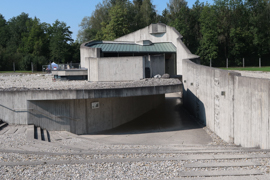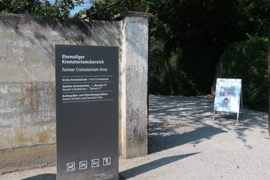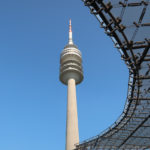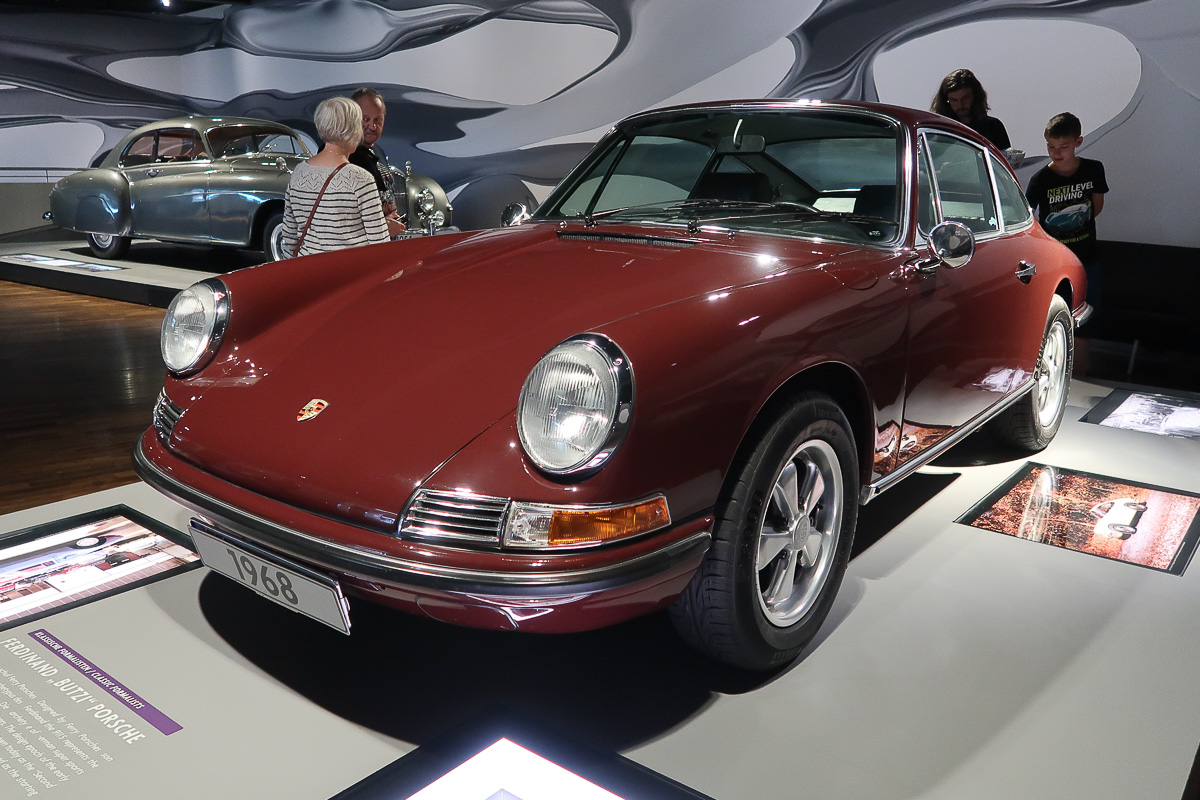Especially in the recent past, I read a couple of ridiculous comparisons between certain people and political groups (which I would definitely agree that they are not on the friendly side of life) and Nazi organisations like the SS. I don’t know how these comparisons really arise, especially from US-American people, but I felt the best way as a travel blogger is to show the people what Nazi and SS cruelty really meant. Thus, I might spam you with some (more) Nazi Germany memorials here on Flyctory.com. After being in Braunau (Hitler’s birthplace) and the Castle Hartheim Killing Center, this posting is about the Concentration Camp Memorial in Dachau near Munich.
Please note that this posting displays massive historic cruelty.

Dachau Concentration Camp – Brief History
Giving you a compact overview about the history of Dachau Concentration Camp is very difficult. Thus, I explicitly refer to the corresponding Wikipedia article.
Dachau Concentration Camp has been founded on 22nd March 1933, just three weeks after Hitler came to power. It has finally been freed by the US Army on 29th April 1945. It is the first continuously operating concentration camp during that time and is thus comparably famous. Initially majorly imprisoning political enemies, people were kept there later for other reasons. Overall, there were 200,000 Dachau prisoners. Roughly 41,500 of them died on the Dachau grounds, however a significant additional proportion of victims were murdered in execution camps or killing centers.
Today: 800,000 visitors per year
Nowadays, the Dachau Concentration Camp Memorial is visited by some 800,000 people per year. As I visited Dachau in September 2020 (i.e. during the Covid-19 pandemic), the number of people you see in the pictures may be uncharacteristically low.
Dachau Concentration Camp – Location & Admission
The concentration camp site is located on the East side of Dachau. It is quite a bit away from Dachau station, but regular buses connect between the station and the memorial. If you arrive by car, there is a really major parking lot with a parking fee of 3 Euro. The concentration camp and even some of the remote sites are very well signposted.
Entrance to Dachau Concentration Camp is free. Daily opening times are 9:00 to 17:00 hrs. A minimum age of 12 years is recommended. I highly support it – first of all, there are of course several pictures of severe cruelties, especially in the main exhibition. Secondly, even if you rush through the site, you will easily spent three hours there. I saw a couple of young children which became bored and behaved in a way I would not see as appropriate for a place like that.


Dachau Concentration Camp – Service Center & Gate
As said above, you should at least take three hours to visit the memorial site. If you want to explore certain topics more deeply, you should even not arrive in Dachau before noon in order to avoid issues with the closing times. There are audio guides in multiple languages. Practically, all locations and exhibits are additionally documented with English and German signs.




You enter the concentration camp memorial through the main entrance gate, just as a vast majority of the prisoners did. The gate is likely one of the most well-known places in Dachau, the cynical slogan Arbeit macht frei (“Work sets you free”) made it very famous. The gate is no longer the original one, after it had temporarily been stolen. The original gate has been found thereafter in Norway and is now part of the main exhibition. Before you enter the grounds, you may also visit the rail ramps, which was the main transportation method to Dachau.
Comparably recently, the memorial revealed the original cobblestones, which the prisoners had to walk along. After passing the gate, you are more or less right at the roll call ground, where the prisoners have been counted every morning and evening.












Dachau Concentration Camp – Main Exhibition
The former management building hosts the main exhibition of Dachau Concentration Camp. There are some remains of the former cruelties, but overall the building is just grey and neutral inside. The main exhibition takes you through different ages of Dachau concentration camps, including how life changed (not only by different people held there). The whole exhibition is very illustrative (again, this makes this place unsuitable for young children). It starts at the very early days of the camp, explaining how the Nazi party could become that powerful. It also illustrates the fate of the first prisoners in Dachau.
In this section, you also learn how arriving new prisoners have been registered and how they had to leave all their belongings and especially valuables. The prisoners were de-personalized, e.g. by cutting off their entire hair. The former prisoners’ bath, which has been rarely available to the victims, also illustrates the cruelties by the SS to the imprisoned. There have even been a few trials against these abuses at the beginning, but of course, the Nazis more and more replaced the judges.






















Over time, Dachau Concentration Camp became more and more crowded (so that the camp by far exceeded its capacity). Random prisoner murders happened as regularly as well as people simply dying due to the massive workload they had to fullfil. The exhibition splits the history of the camp into two era, 1939 to 1942 and the time thereafter until its liberation. Especially in its later years, diseases became more regular so that there were disinfection troops. Short before the liberation of Dachau, there were riots among the prisoners, as the situation was just unbearable. At the end of these sections, you may also watch the original Dachau concentration entrance gate – which is nowadays highly secured against (a new attempt of) theft.



















Towards the end of the main exhibition, there are some references to one of the outposts of Dachau Concentration Camp, Allach – Karlsfeld. You learn about the camp and its importance for the industry, especially for BMW. There are quite a lot of original exhibits. Next door, there is a room of remembrance with memorials for numerous individuals and groups of people.









Dachau Concentration Camp Grounds
You typically visit the main exhibition of Dachau Concentration Camp before you head to the grounds and the other locations of the memorial site. Even though it just represents the core area of the former concentration camp, it is large and requires a lot of walking.
Barracks and Grounds
Like most of the original concentration camp grounds, most of the barracks have been destroyed after liberation of the camp. The location of the original barracks are however marked on the ground, Barrack 1 has been rebuilt in order to illustrate the life of the prisoners. Due to Covid-19, you could unfortunately not get into the barracks. Apart from that, you see the wide area with the walls and watchtowers. If you approached these ones too closely, you were subject of being shot immediately. The impressive installation in front of the main building was in restoration process during my visit (thus, you just see a poster of it on some pictures).

















On the pictures below, you see the markings of the original barracks’ locations. The area is really wide and requires quite some walking.







Close to the Northern and of the memorial side, there is an illustration how additional trenches and barb wire has been used to prevent the prisoners from fleeing.





Religious Memorials / Places of Worship
The Northern end of the memorial hosts three places of workshop. On top, you see the protestant Church of Reconciliation (Evangelische Versöhnungskirche), followed by the catholic Agony of Christ Chapel (Todesangst Christi Kapelle). Next to them is the Jewish place of worship. The orthodox place is a bit hidden, closer to the crematories (see below). Former organisational building are nowadays used by Carmelite nuns.











Crematories and Burial Sites
Walking over a small bridge at the edge of the concentration camp memorial grounds, you reach the crematory site. Several monuments remind of the people who died here, like a stone reminding Denket daran wie wir hier starben (“Remind how we died here”) or a statue of a prisoner stating Den Toten zur Ehr, den Lebenden zur Mahnung (“Honoring the dead, urging the living”). On your left, you see the first / historic crematory building with the historic crematory oven.








Opposite to it is the original crematory building. The most impressive part to me was that the building had shafts to enter Zyklon B (Hydrogene Cyanide) capsules into the gas chamber in order to murder prisoners. In fact, this has been very rarely used in historic practise – cyanide was however indeed used to disinfect the clothing of the dead and prisoners sentenced to dead before cremation. After visiting these disinfection rooms, you take the route of a prisoner who would have been sent to the gas here up until the crematory site. Hooks in the roof beams remind that people were also hanged here right in front of the running crematories.
















Behind the building, there are several memorial sites. Some of them remind of former execution ranges, other are mass burial sites of corpses buried there during the Nazi era or right after liberation.





Dachau Concentration Camp – Remote Sites
There are multiple still existing historic sites linked to the cruelties of the concentration camp. For example, the former plantage site is still in use. The most important additional memorial is likely the former Herbertshausen shooting range, where thousands of Russian prisoners at war have been murdered. They had to wait in the right shooting lane before they were slaughtered in the left one. There is quite a lot of information about this place available on site. A memorial names all known victims. The former management building is nowadays used for public housing, though. Most places are marked in the map above.














Thereafter I wanted to visit the concentration camp cemetry Leitenberg. Unfortunately, as my car sharing car needed to be opened / closed and activated by a mobile app and the place does not have any internet connection, I had a lot of technical trouble there and could not visit it.

The city center of Dachau also hosts a couple of memorials. There are also a couple of street names reminding of the cruel history of the town, including Straße der KZ-Opfer (“Victims of the Concentration Camp Street”) and Widerstandsplatz (Resistance Square). There is also a walk along a historic routed, which prisoners had to walk to the camp. Close to police barracks, there is also a left piece of the rail tracks to the concentration camp. Not too far away from that place, there is a memorial reminding of the death marches towards the end of WWII.




I also tried to visit the location and memorial of the former Allach-Karlsfeld outpost. However, the site is right in the middle of a comparably run-down living area and quite densely populated, so that I did not even managed to find a parking lot close to it. I could just pass the back of the building, which felt to be in a very inappropriate state.
Dachau Concentration Camp – Services
The visitor center is very friendly and helps with tour suggestions and audio guides. There are toilets on the concentration camp grounds, but there is no food for obvious reasons. The visitor center does offer a snack bar, however. All over the place, there are very friendly and motivated volunteers, who assist you if you have questions. I was impressed by their deep knowledge about the place.


Dachau Concentration Camp – My View
If you are in Greater Munich and somehow can invest three to four hours for a visit, this place will help you massively to understand the cruelties disliked and haunted people had to suffer (and die from) during the saddest part of German history. I feel that the topics discussed in there are still up-to-date, social and racial isolation are still very important topics of our current discussions. You should however be ready to handle the display of death, murder and physical cruelties to visit this place – the unfortunate reality of the history of Dachau Concentration Camp, which is now an outstanding memorial site.
Nazi Germany Memorials
Here are all places memorizing about the cruelties during the German Nazi leadership:

The former concentration camp site at Bergen-Belsen might not be as prominent as Dachau, but it is nonetheless one of ...

The Museum of Jewish Heritage in New York City also calls itself A Living Memorial to the Holocaust. Even though I ...

During the Nazi regency in Germany, the Emslandlager (Emsland Camps) was a group of concentration and detention camps in the Emsland region, ...

It is time for the final posting of the years, simply named The Best Ones 2021. After looking into my ...

The same faith which applies to Oswiecim in Poland (better known under the former German name Auschwitz) is also valid, ...

Auschwitz is a town's name (adopted to German) which you typically link with murder, cruelty, state-organized mass killings, injustice. A ...

A very interesting rebranding: when I started to explore museums in the nearby Netherlands, the Dutch Freedom Museum in Groesbeek ...

It is almost needless to say that Adolf Hitler was obsessed with megalomanic ideas. Apart from ruling the world and ...

The National Monument Camp Vught - or Konzentrationslager Herzogenbusch, which has been the German name during the Nazi era - is ...

Even though the Netherlands capitulated against Germany just after a few days under attack during World War II, they have ...

Nuremberg (or Nürnberg, how it is named in German) has some sort of tough political-historic heritage. Several sites still remember ...

The Weiße Rose / "White Rose" was a resistance group during the German Nazi regime. Mainly consisting of university students, she ...

The Berchtesgadener Land is not only nowadays well-known as a popular tourist destination, there is also a dark part of ...

Nuremberg is deeply linked to the German Nazi regime between 1933 and 1945. The key reason for that are of ...

When you think about Nazi Germany murders, you typically think of extermination camps like Auschwitz or the concentrations camps. A ...

Braunau am Inn - the small town right at the Austrian-German border is indeed a picturesque place and a nice ...

On 21st October 1941, the German Wehrmacht slaughtered thousands of civilians in Kragujevac, Serbia, to revenge dead and wounded soldiers ...

The Royal Ontario Museum just feels like an amazing wonderland of topics, a bit of "something for everyone". Did you ...
Flyctory.com in Munich
Here are all other Flyctory.com postings related to Greater Munich:

Due to physical issues, I had to completely stop publishing reviews on Flyctory.com this week. One impact was that I ...

31st October, Happy Halloween! Especially on the North American music market, Trick or Treat creates a rather low volume new music ...

The Münchener Residenz ("Munich Residence") is one of the most iconic places in Munich. From 1508 to 1918, it was home of ...

I am still on the Faroe Islands, briefly before I am about to leave my favorite islands. There is also ...

It's Saturday again, time for another look into new songs. My week this time is somewhere between tennis excitement and ...

For a business trip to Munich in July 2025, I was looking for a cheaper stay in the area North ...

I really like flying to or from Munich Airport (MUC) or having a transfer there (at least in Lufthansa's Terminal ...

The last match of the German Under 15 Floorball Nationals was about to start. PSV Black Wolves Dessau and FBC ...

After the Saturday Group Matches (Group A / Group B), four teams were still in the Medals' Bracket on the ...

Six teams overall competed for the German Under 15 Floorball Champion in Bremen. While I already introduced you to the ...

Even though I comparably rarely stay in them, I typically like Leonardo Hotels. For a company event (rafting on the ...

This week, I am having my final shows of the German Rock of Ages tour. After the intense musical and ice hockey ...

While the US-American country scene was really active in releasing music, there were not too many new songs and albums ...

After I already took you on a Visitor Tour through Munich Airport (MUC) in a previous post, here is another ...

Coming back from a trip to Krakow, I more or less immediately ran into the new releases as of 28th ...

The 2025 Country To Country in Berlin took quite a lot of energy from me. On top of that, there ...

I had a quite frustrating week. My accreditation requests for four photography events, three sports reports an one concert, have ...

Happy Thanksgiving (especially to my North American followers)! While the North American music market is currently rather concentrating on Black ...

Spending some time in and around Munich Airport (MUC), I also took the opportunity to have their Airport-Live-Tour, the basic bus tour ...

Are you already counting down the days to Christmas? You definitely feel an impact on the music industry of the ...

Hungary this weekend! After my trip to Indonesia, I am back in Hungary after such a long time of absence ...

I am writing this post from Abu Dhabi Airport (AUH), I will likely publish it from Doha (DOH). A cool ...

Maybe it is because I had to do some long evenings to prepare my Media Review coverage for the weekend of ...

Having a nice walk in the (somewhat) nature and meeting some animals out there - the weather was just too ...

This week, my Songs of the Week are full of pop tracks. There is a lot of sports coverage on Flyctory.com ...

I feature athletics events three weeks in a row before I head to Newport in Rhode Island for tennis coverage ...

A rail strike destroyed our travel plans in and around Munich in March 2024. Thus, on a rather short notice, ...

Munich is always a special place to me. As parts of my family roots are from there, I always feel ...

This time, selecting the leading track of my Songs of the Week was really troublesome. Three candidates have already been released ...

Returning from the World Floorball Championships in Finland, heading directly to a business trip to Paris - this week was ...

At the time when I started writing this posting in early March 2024, Flyctory.com already featured reviews of over 320 ...

Coming back from the United Arab Emirates and about to head to Malaysia soon - thus, some really interesting experiences ...

January 2024 has already passed and we are running into the first February 2024 edition of my weekly release radar ...

I still feel that in many athletics meetings, the track events are somehow still more in focus than the field ...

This week, I published how I feel to concentrate on one Country Music Playlist - at least until I found ...

This time, my Songs Of The Week consist of 14 new releases as of this week. The Christmas break is definitely ...

It's Christmas Eve, the main day of the Christmas celebrations in Germany. However, all the holiday songs seem having been ...

Unfortunately, I could not complete the Country Christmas Playlist this year due to technical issues. However, since the days become ...

I am a bit of angry as the tool I loved to use to scan for new country releases does ...

December, when the frequency of album releases significantly decreases, is also a time for me to have some more outside-of-the-box ...

I had a short trip to Hamburg this weekend, watching my last Nacht der Gitarren show (see my Reutlingen show report) ...

I always love being able to look into new names, new sounds, new bands. This one is about the rock ...

Just two months until Christmas. You feel that in my this week's edition of the Songs of the Week definitely. First ...

I spent almost the entire week at work in Dublin at one of our offices. Quite an intense time, which ...

There is somehow always some sort of "topic" behind each and every Songs of the Week episode. If I would pick one ...

The Songs Of The Week is one of my favorite categories of posts on my blog. Even I don't know how the ...

It is just mid-year 2023 and I already start working on my 2024 Rock of Ages International Tour list. I am sure ...

Wow - I had so many albums this week. Even if I skipped all travel posts and do the regular ...

Home is where the heart is - I had the idea to this posting about my favorite cities of the ...

I never know what is really happening when I compose a new episode of my Songs of the Week. Until Friday, ...

World class athletics in walking distance to my home? The #TrueAthletes Classics in Leverkusen has been on my bucket list ...

With this fourth posting, I am closing my coverage of the German Athletics Nationals 2023. The Auestadion in Kassel hosted ...

I start my coverage of the second day of the German Athletics Nationals 2023 in Kassel with the field events ...

I am a huge fan of the field events in athletics - and thus, I am really glad to also ...

The German Athletics Nationals (or German Athletics Championships... or Deutsche Leichtathletik-Meisterschaften) 2023 in Kassel were truly one of the events I ...

Traveling out of nowehere: I compiled this set of songs in Swansea in Whales, watching the very last Rock of ...

My visit at the Sea Life in Munich has still been under Covid-19 regulations. However, I feel that most of ...

I received so many great albums this week - no chance to process a fair fraction of them. However, the ...

I have struggled quite much with health issues this week - which also prevented me to travel to some British Rock ...

I received the album Maniac by the Munich post-hardcore band Marathonmann way before its release on 19th May 2023. Short message: I ...

After some rather intense traveling, I am glad that there is just a short trip this week. I concentrated on ...

I have to give in: the red carpet is not my favorite location. Nonetheless, I felt very thankful that after ...

I had seen the musical Rock of Ages 73 times before this show - but show #74 made me kind of extra-nervous ...

I am always impressed where the Songs of the Week each weekend finally end of. This time, for example, i have been ...

Damn - just when I had a massive travel volume, the number of new releases of all genres went up ...

Ireland, the United Kingdom, Belgium, the Netherlands, USA, Canada - and of course Germany lay ahead of me for the ...

An album with a bunny - how could I not give a review of Warlord, the album by the stoner rock band ...

For some reviews, I just need much longer than expected to find a good slot in my publication planning. One ...

Despite the project name sounds rather Ruhrgebiet-alike, Umme Block are an electronic pop duo from Munich. The German artists release ...

AIthough has just been a day trip, but I just felt it is too long to tell the story of ...

Okay, I give in: this trip is weird. While people typically feel that I am "just" a die hard aviation ...

Welcome to the first Songs of the Week posting in 2023! Despite the music industry is slowly getting back to business, I ...

I guess that the next weeks will be more intense. Depending if you look at the publishing or the cut-off ...

Asam Church in Munich is regarded to be the most beautiful church in the Bavarian capital. Thus, on one of ...

October is quite a busy time for me. Private and business trips take most of my time. My Songs of the ...

It's already quite a while ago since I visited the Deutsches Jagd- und Fischereimuseum, the German Hunting and Fishing Museum, in ...

BMW - the Bayerischen Motoren Werke are definitely one of the most famous companies of Munich and a synonym for German ...

Rock and harder rock styles have been a bit of under-represented in here the last weeks. The more I am ...

Rather dark rock tunes from Munich: the Band Versus Goliath is releasing their album Liebe & Chaos on 12th August 2022 ...

LustfingeR is named to be one of the oldest punk / punk rock bands in Germany. The Southern German band ...

Okay, this week, my Songs Of The Week listeners need to stay strong: I started my list with schlager (with a touch ...

From the senior girls to the very young ones: while the Dümptener Füchs from Mülheim, Ruhrgebiet region, just have become ...

I had a long list of songs for my Songs of the Week... and after I composed a nice order of ...

The Deutsches Museum (literally: "German Museum") is an amazing technical and scientific museum in the heart of Munich. While I just did ...

I typically love glam rock - and thus, the German band Shameless had a rather easy time to get into ...

I just happened to run into the music of KIDSO (which is written as KIDSØ, but I try to avoid ...

The website of Tame The Abyss introduces themselves as Your new favorite band. In order to gain this kind of global ...

In January 2022, I had a rail trip to Munich. As I arrived rather late, the Hampton by Hilton Munich ...

I have been a bit of puzzled when I arrived in Munich in late January 2022, learning that the Stammstrecke, the ...

Rickie Lee Kroell, the second time: I just introduced you to the pop artist and her new EP Hauptsache was mit ...

In later 2021, I ran into the music by German-American artist Rickie Lee Kroell by a contact to her promotion ...

The DFEL (German Women Ice Hockey League) leader traveling to the bottom team of the table (which had, to be ...

Especially when I am in London, visiting a stage play is always a must on my list (time permitting). One ...

It's been quite a while since I released my previous Spotlight interview. The more, I feel flattered to dip into ...

As Munich Airport (MUC) is one of my most traveled ones, I know the business lounge situation there quite well ...

Arriving late from my Lübeck Air flight from Lübeck Airport (LBC), heading out early for my train to Bolzano in ...

Fancy has truly been a Eurodance legend in the 1980's. Even though his last Top 20 chart entry, a mix ...

Professional stargazing: The European Southern Observatory, short ESO is a collaboration of multiple European countries to gather astronomic forces on the ...

It's been just too long since I did the last episode of my Country Music Picks. At the end of ...

Undoubtedly, Munich Olympic Tower is one of the iconic buildings of the Bavarian city. Even though the tower is located ...

While so far the only German dialect I feature on Flyctory.com is Kölsch, the lovely way to speak in my ...

Gehst Du mit mir unter - "Are you drowning with me" is the album title of a new German music project ...

The Weiße Rose / "White Rose" was a resistance group during the German Nazi regime. Mainly consisting of university students, she ...

I already introduced you to Feli, the German Girl in America, now Feli from Germany, in my Flyctory.com posting about her ...

Due to a late rail arrival at Munich Central Station, I looked for an overnight opportunity around the central travel ...

The Munich Toy Museum is one of these typical hidden gems you find in many cities. Right in the city ...

There is no better start of the day for Munich people than a Weißwurst breakfast with a prezel and a beer. The Weißwurst, ...

Before Germany went to a lock-down of touristic travel in November 2020, I had a short trip to Munich. For ...

For a stay in September 2020, I tested the Hilton Garden Inn Munich City West for two nights, Friday to ...

Similar to the Europarad Ferris Wheel in Cologne, Munich is hosting a giant mobile ferris wheel, which is offering its ...

A legendary architecture (many people even regard it to be the most important building in the city), a sheer endless ...

One thousand kilometres to the sea - or vice versa One thousand kilometres to the Alps - was the slogan a new private ...

While - especially for business reasons - trans-European rail connections may still take too much time for daytime transfers, night ...

2020 is just halfway done - but if I was to choose a German person of the year, regardless whether ...

Arriving at Munich Main Station by rail at 22:00, grabbing a rental car there at 8:00 (earliest possible time during ...

Heading back home. As said in the Day 3 coverage, I did not expect too much going on on that ...

The Hofbräuhaus is one of the maybe most well-known and iconic places in Munich, Germany. Even if you don't care about ...

If you fly a non-Schengen flight from Terminal 1 (the non-Lufthansa one) at Munich Airport and depart from the B ...

While I so far made an semi-annual look back in time, the "Very Important Postings", I decided something with my ...

After I had some stays at Hilton Munich Airport in the past, I was happy to be back in this ...

The reviews I found so far are quite clear: 9 out 9 users assigned a 1.0 to the Eurowings Lounge ...

After reviewing four Christmas markets in Cologne recently, I did not expect to get in touch with any additional ones ...

Due to the limited exhibition space of the "Deutsches Museum" (German Museum of Technology), the famous Munich educative center had ...

"Stylish", "Surprising" or "Modern design" might not really be the attributes which you combine with ibis hotels. The more I ...

As I for example stated in my review on Louvre Abu Dhabi, I am quite much interested in ancient cultures ...
















































































































































































































































































































